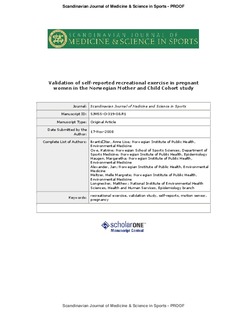| dc.contributor.author | Brantsæter, Anne-Lise | |
| dc.contributor.author | Owe, Katrine M. | |
| dc.contributor.author | Haugen, Margaretha | |
| dc.contributor.author | Alexander, Jan | |
| dc.contributor.author | Meltzer, Helle Margrethe | |
| dc.contributor.author | Longnecker, Matthew P. | |
| dc.date.accessioned | 2010-04-30T09:26:12Z | |
| dc.date.available | 2010-04-30T09:26:12Z | |
| dc.date.issued | 2009-03-29 | |
| dc.identifier | Seksjon for idrettsmedisinske fag / Department of Sports Medicine | |
| dc.identifier.citation | Scandinavian Journal of Medicine & Science in Sports. 2010, 20(1), e48-e55 | en_US |
| dc.identifier.issn | 0905-7188 | |
| dc.identifier.uri | http://hdl.handle.net/11250/170613 | |
| dc.description | I Brage finner du siste tekst-versjon av artikkelen, og den kan inneholde ubetydelige forskjeller fra forlagets pdf-versjon. Forlagets pdf-versjon finner du på www.wiley.com: http://dx.doi.org/10.1111/j.1600-0838.2009.00896.x / In Brage you'll find the final text version of the article, and it may contain insignificant differences from the journal's pdf version. The definitive version is available at www.wiley.com: http://dx.doi.org/10.1111/j.1600-0838.2009.00896.x | en_US |
| dc.description.abstract | We compared the self-reported frequency of recreational exercise and corresponding metabolic equivalent (MET)-minutes with physical activity measured with a position and motion sensor in pregnant women. One hundred and twelve women in the Norwegian Mother and Child Cohort Study (MoBa) completed questions about weekly participation in recreational exercise by week 17 of pregnancy and participated in the validation study around week 20. Data from a validated motion sensor (ActiReg®) that measures physical activity and total energy expenditure (TEE) served as the "gold standard." Self-reported recreational exercise was compared with the following ActiReg®-based measures: physical activity energy expenditure (PAEE), minutes of vigorous physical activity (VPA), physical activity level (PAL) and TEE. Pearson's correlations between self-reported weekly exercise and the objectively assessed variables were: rPAEE=0.26, rVPA=0.32, rPAL=0.30 (all P<0.01) and rTEE=0.17 (P=0.07). The partial correlation coefficients between the questionnaire responses and the ActiReg® measurements were similar after adjusting for parity, body mass index, education, age, height and smoking, but rTEE increased (r=0.27, P<0.01). We observed significant positive associations between self-reported exercise activities and motion sensor measurements of physical activity, indicating that the questions used for exercise assessment in MoBa may be useful for ranking pregnant women according to the recreational exercise level. | en_US |
| dc.language.iso | eng | en_US |
| dc.publisher | Wiley | en_US |
| dc.subject | recreational exercise | en_US |
| dc.subject | validation | en_US |
| dc.subject | motion sensor | en_US |
| dc.subject | pregnancy | en_US |
| dc.title | Validation of self-reported recreational exercise in pregnant women in the Norwegian Mother and Child Cohort Study | en_US |
| dc.type | Journal article | en_US |
| dc.type | Peer reviewed | en_US |
| dc.subject.nsi | VDP::Social science: 200::Social science in sports: 330::Other subjects within physical education: 339 | en_US |
| dc.source.pagenumber | e48-e55 | |
